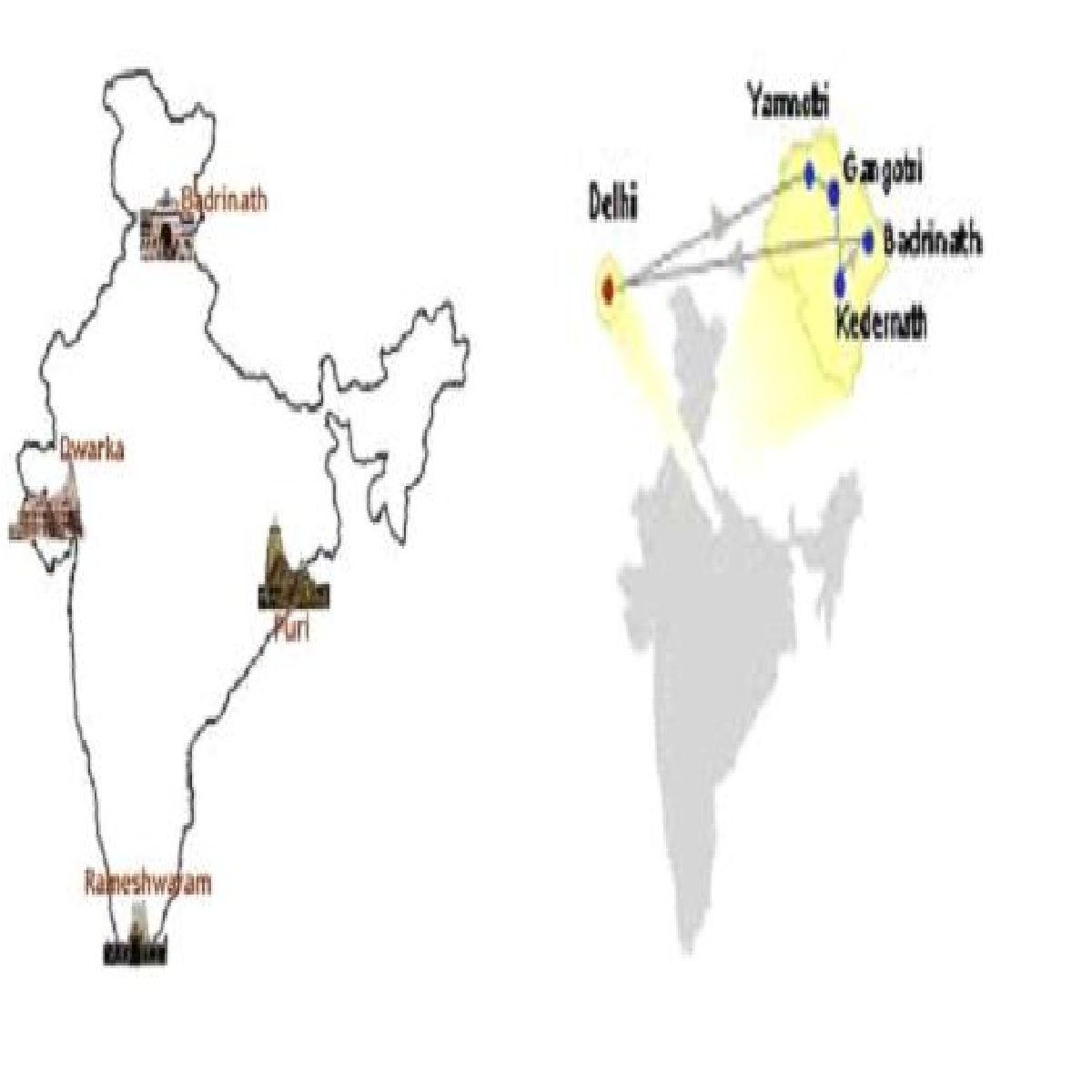Tuesday, April 30, 2024
Monday, April 29, 2024
Tuesday, April 2, 2024
Monday, April 1, 2024
Thursday, March 14, 2024
Wednesday, February 28, 2024
Tuesday, January 30, 2024
Sunday, January 28, 2024
Tuesday, January 9, 2024
pair
Hari (Vishnu) and Hara (Shiva) are called eternal friends in the Puranas. It is said wherever Vishnu resides; Shiva resides nearby. The Char Dham follows this rule. So Kedarnath is considered as the pair of Badrinath, Rama Setu is regarded as the pair of Rameswaram, Somnath is considered as the pair of Dwaraka, and Lingaraja is regarded as the pair of Jagannatha Puri. However, according to some traditions, the Char Dham are Badrinath, Ranganatha-Swami, Dwaraka, and Jagannatha-Puri, all of which are Vaishnava sites, and their associated places are Kedarnath, Rameswaram, Somnath and Lingaraja Temple, Bhubaneswar (or maybe Gupteshwar) respectively.
https://freeglobaluniversity.blogspot.com/search/label/ShivaVishnu
Defined by Adi Shankaracharya
Description
Badrinath became prominent when Nara-Narayana, an avatar of Vishnu, did Tapasya there. At that time that place was filled with berry trees. In the Sanskrit language, berries are called "badari", so the place was named Badarika-Vana, that is, the forest of berries. The particular spot where the Nara-Narayana did Tapasya, a large berry tree formed covering him to save him from the rain and the sun. Local people believe that Lakshmi became the berry tree to save Narayana. Post-Tapasya, Narayana said, people will always take her name before his name, hence Hindus refer "Lakshmi-Narayana". It was therefore called Badri-Nath, that is, the Lord of Berry forest. This all happened in the Satya Yuga. So Badrinath came to be known as the first Dhama. The temple is located on the banks of the Alaknanda River in the Chamoli district of Uttrakhand.
The second place, Rameswaram, got its importance in the Treta Yuga when Rama built a Shiva-Lingam here and worshipped it to get the blessings of Shiva. The name Rameswaram means "God of Rama". It is believed that Rama's footprints are imprinted there.[6]
The third, Dwaraka, got its importance in the Dvapara Yuga when Krishna made Dwaraka his residence instead of Mathura, his birthplace.[7]
At the fourth, Puri, Vishnu is worshipped as Jagannatha, his avatara for the current epoch i.e Kali Yuga.
Labels
- 12 Year Journey (1)
- 1234 (1)
- 130 Years Old Unseen Photos of Kedarnath (1)
- 2000 (1)
- 6th Kedar / Panch Kedar / Winter Seat / Tour / Shradha / Samadhi (1)
- AdamEve (1)
- AdiKailash (1)
- Alakananda (1)
- almora (1)
- Ambani (1)
- Ancient (1)
- anilkrghij (1)
- Anup Jalota (1)
- Army (1)
- Badrinath Common to Major and Minor dhams (1)
- Bagnath (1)
- Bedupako (1)
- Bhim (1)
- Booking (1)
- Char Dham - Hindi Film (1)
- Charm (1)
- Chaukhamba (1)
- Chipko (1)
- chirpine (1)
- Climatic Conditions in Minor Dhams (1)
- CM (1)
- Company (1)
- Defined by Adi Shankaracharya (1)
- Dehradun (1)
- Description (1)
- devbhoomi (1)
- Dhari Devi / Tube (1)
- Dunagiri (1)
- e (1)
- FairyLand (1)
- Feminine Version (1)
- Fifth (1)
- Four Dhams in Vrindavan (1)
- Four Major and Minor dhams (1)
- Four Major Dhams Yugas (1)
- Gagar (1)
- Ganesha (1)
- Gangotri / Yatra / See / Seva / Glacier / Gomukh / Tapovan / Fall (1)
- Gangotri Yamunotri Fact File / Birth place / Asit / Beliefs / Devi (1)
- Garhwal (1)
- Gaura (1)
- Gaurikund on the way to Kedarnath / Tube (1)
- Glaciers / Trek Uttaranchal (1)
- Golu (1)
- Gopeshwar (1)
- Green (1)
- Guide (1)
- Gunji (1)
- Guptakashi (1)
- Haldwani (1)
- HanumanChatti (1)
- Heaven (1)
- helicopter (1)
- Hillore (1)
- HowKedarnath (1)
- human (1)
- incredible (1)
- Jain (1)
- Jubin (1)
- kalimath (1)
- kalpa kedar (1)
- Karauli (1)
- kasar (1)
- Kashipur (1)
- Krauncha (1)
- krushangsoni (1)
- lakhamandal (1)
- last (1)
- Legend (1)
- Liberation (1)
- libroesoterico (1)
- Location of four Major dhams on Google Maps (1)
- Mahamarg (1)
- Major and Minor dhams Video (1)
- Major Dham Tour Operators (1)
- Major Dhams Video (1)
- MajorDhams (1)
- mana (1)
- Mera Pahad Forum (1)
- Minor dhams / Pilgrim / How to Go (1)
- Minor Dhams Hotels (1)
- Minor dhams Short / Detail Videos (1)
- Minor Ek / Do / Teen / Char Dham Tour Operators (1)
- Mountain (1)
- Mukteshwar (1)
- Munkatiya (1)
- Namchi (1)
- Namo (1)
- Nanda Devi (1)
- Navaratna (1)
- neha (1)
- Nepal (1)
- News18 (1)
- Nilkanth Varni Panch Dham Yatra (1)
- OSHO (1)
- owner (1)
- Package (1)
- pair (1)
- Palm (1)
- Panch Kedar (1)
- Panch Prayag - Tour Operators (1)
- Panchala (1)
- PanchPrayag (1)
- Param (1)
- PatalBhuvaneshwar (1)
- Pauri (1)
- Pawandeep (1)
- Pithoragarh (1)
- Pradeep Mehra (1)
- President (1)
- Protector (1)
- R-Day (1)
- Raghav (1)
- Rail (1)
- Rameswaram - One of 4 Major Dhams and 12 Jyotirlingas (1)
- RaniKarnavatiGarhwal (1)
- Replica (1)
- Rescue (1)
- Rishikesh Haridwar - Entry Points to Minor Dhams - 3 Maps (1)
- Road (1)
- Roopkund (1)
- Sacred (1)
- sadhana (1)
- Satopanth (1)
- Shadi (1)
- shantanand (1)
- Shiva and Vishnu (1)
- Shravan (1)
- Shri Badrinath - Shri Kedarnath Temple / Committee / Yatra (1)
- silkyara (1)
- Someshwar (1)
- sonu (1)
- Tapkeshwar (1)
- Triyuginarayan (1)
- Types (1)
- Underground way to dhams through Mahakaleshwar – Ujjain caves (1)
- Uttarakhand Duryodhana and Karna Temple (1)
- vandana katariya (1)
- viral (1)
- Vishwakarma (1)
- Wait (1)
- Yatra (1)
- Yogi (1)



